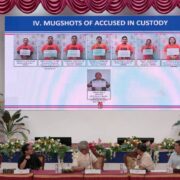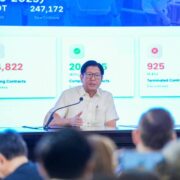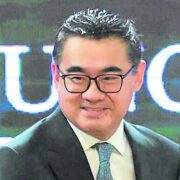Search for the illusive fountain of youth

The buzz words among seniors, especially incumbent and retired jurists, are what I call “lovely longevity”—the art of putting more life to our years under God’s providence, not just adding more years to our lives. I have several chat groups advocating an active, healthy, and happy life until 100 and beyond. Among them are “Happy Seniors 100,” “Sousai 100,” “Retired SC Justices 100+,” and “Team Lenggries 100 and Beyond.”
THIS ELUSIVE SEARCH FOR THE ILLUSIVE FOUNTAIN OF YOUTH IS NOT NEW. It was made famous by the Spanish explorer Juan Ponce de León when in 1513 he roamed the marshes and jungles of Florida looking for the fabled “fountain of youth.” The average lifespan then was only 32.
But long before him, the Egyptian pharaohs and the Chinese emperors directed their minions to find magical ways to everlasting life. Tao, a descendant of Lao-tzu, promised immortality to men who could sexually satisfy their partners a dozen times per day. The Old Testament relates that Abraham was 100, and his wife Sarah was computed to be 90 when their son Isaac was born. However, according to Islam, the firstborn of Abraham with Hagar, the handmaiden of Sarah, was Ishmael.
Science and medicine have unquestionably prolonged life. The discovery of penicillin by Alexander Fleming in 1928 healed bacteria-caused ailments. Anesthesia relieved surgical and other pains. Vaccines and sanitation conquered epidemics and plagues. Viruses can one day be subdued. So, too, biotechnology—supported by artificial intelligence or AI—will discover cures for cancer, heart diseases, dementia, and other existing incurables.
BEYOND SCIENCE AND MEDICINE IS THE BEST SELLER, “Blue Zones—The: Lessons for Living Longer From the People Who’ve Lived the Longest” by Dan Buettner. Serialized in four episodes on Netflix, the author visited five places in the world where the inhabitants lived the longest and happiest: Okinawa (Japan), Ikaria (Greece), Loma Linda, California (USA), Sardinia (Italy), and Nicoya (Costa Rica). These places had 10 times more centenarians compared to the rest of the United States on a per capita basis.
He observed eight commonalities among the centenarians: First, their diet was primarily plant-based, mostly fruits and veggies with very little meat.
Second, they moved their bodies “naturally” like all day walking, gardening, and doing house chores.
Third, they valued social life—frequent contact with relatives, singing and dancing with friends, and freely mingling with their communities.
Fourth, they pursued a sense of purpose. The Japanese call it “ikigai,” translated roughly to “a reason for being.”
Fifth, they had adequate sleep in both quality and quantity.
Sixth, they reduced stress. Seventh, they didn’t fill up; they stopped eating when they were 80 percent full. And eighth, they grew their own fruits and vegetables or had easy access to them.
The big surprise in the Netflix series is the choice of Singapore as the place to reach 100 or more years. The average lifespan there has risen to 84 years—compared to the global 73—as a result of policy nudges to eat healthier, an efficient public transport system and park network to encourage people to walk more, imposing an expensive vehicle entry fee to the city center that lessened pollution, and a world-class health care and competitive education systems.
However, it’s very expensive to live in Singapore. It’s a first-world country with a per capita income higher than that of the Americans.
I AM NOW IN GERMANY WITH TEAM LENGGRIES 100 searching for the elusive fountain of youth in the foothills of the Bavarian Alps in a “ritzy suburb” about 50 kilometers south of Munich and in the nearby Swiss towns around Lake Geneva where in 1931 Dr. Paul Niehans founded the “living cell therapy,” continued by his capable acolyte, Dr. Siegfried Block and later by his daughter Dr. Petra Block and grandson Dr. Daniel Block. Today, Germany has more than 500 specialists in cell therapy and about 5,000 who occasionally prescribe it.
Their almost a century of medical practice (1931 to the present) brought youthful looks and revitalized health to historical figures like Pope Pius XII (who appointed Niehans to the Papal Academy of Sciences in 1955 making him a worthy successor to penicillin discoverer Fleming), Charles de Gaulle, Emperor Hirohito of Japan, King Abdullah of Saudi Arabia, Harry Truman, Marilyn Monroe, Madonna, and Pablo Picasso.
Very briefly, “a living cell therapy means that cells and minute cell unions derived from unborn or young” cancer-resistant mountain sheep from Dr. Siegfried Block GmbH’s own herd of about 700 “are extracted under clinical conditions in its EU-certified laboratory, suspended in a natural solution and immediately injected” within 40 minutes from the slaying of the sheep into the buttocks of the patient (about eight to 10 shots). These “newly injected live cells will stimulate, revitalize, and restore the patient’s weakened tissues and organs.”
Will this almost magical therapy heal and revitalize our Team Lenggries 100? Will it make old age worth living? Well, I will tell you within four to 12 weeks when the treatment is supposed to fully work its wonders.
chiefjusticepanganiban@hotmail.com


















